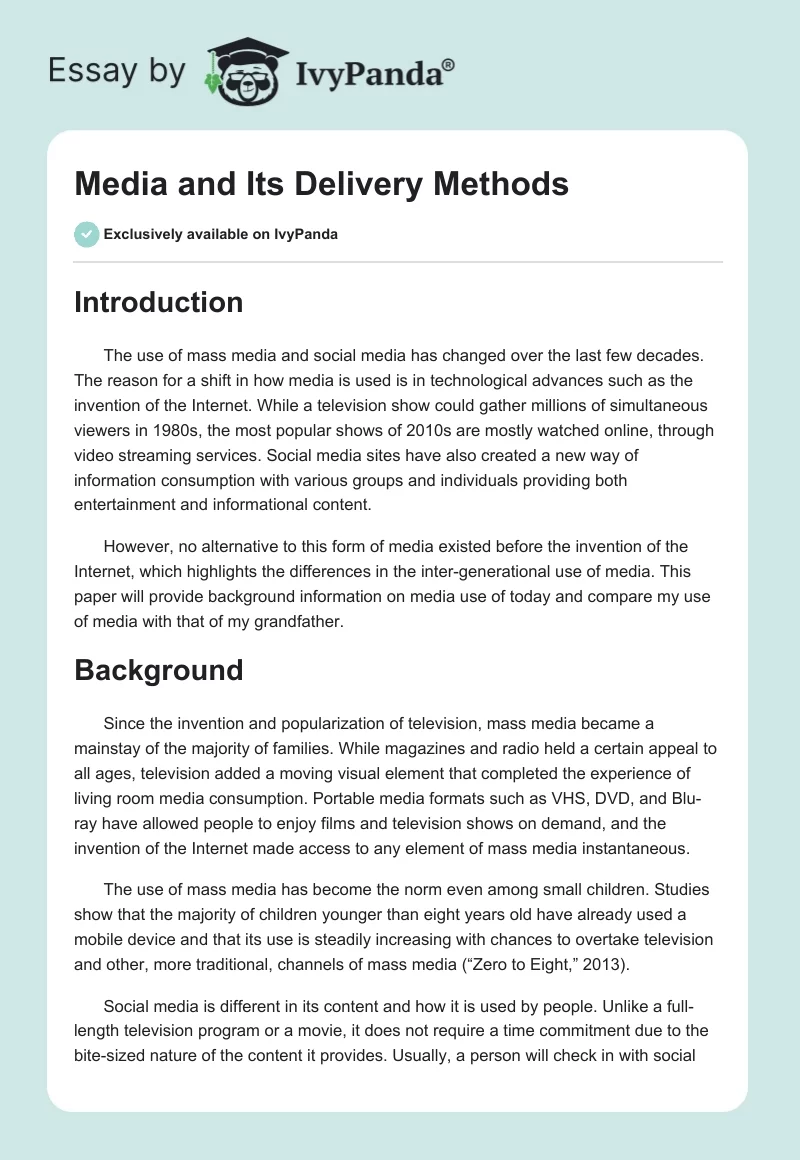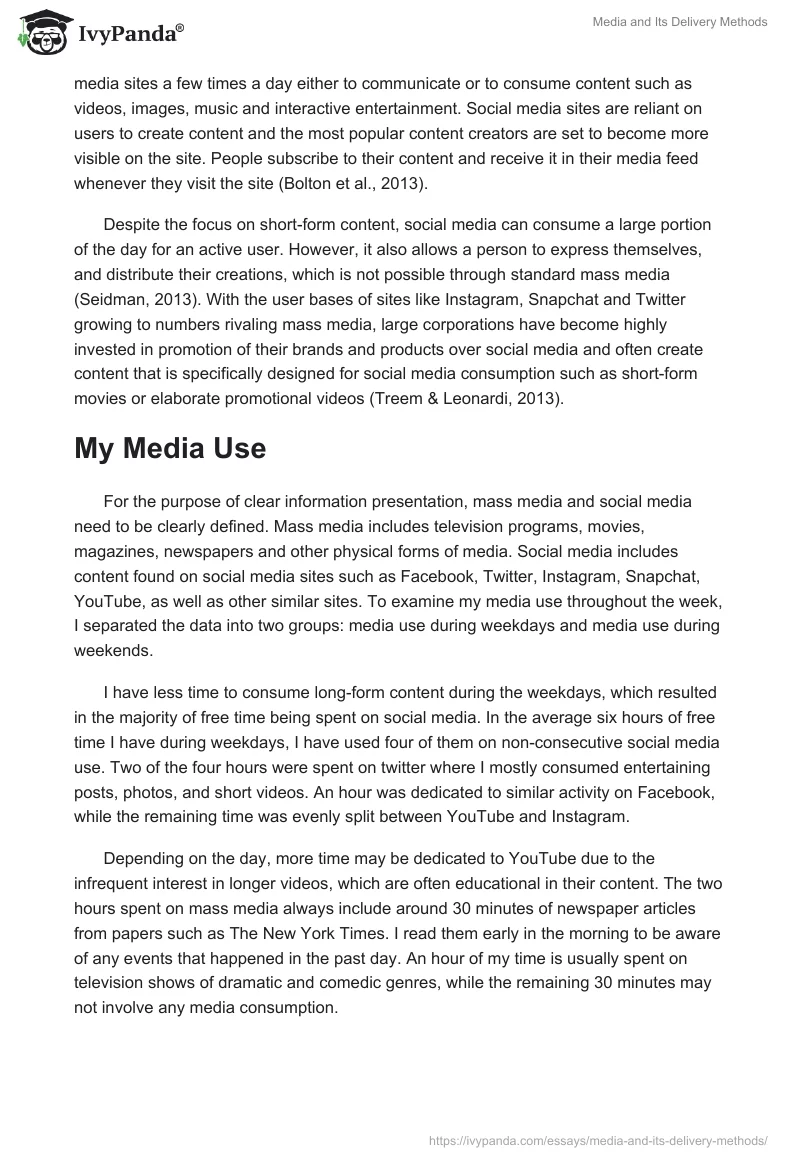Introduction
The use of mass media and social media has changed over the last few decades. The reason for a shift in how media is used is in technological advances such as the invention of the Internet. While a television show could gather millions of simultaneous viewers in 1980s, the most popular shows of 2010s are mostly watched online, through video streaming services. Social media sites have also created a new way of information consumption with various groups and individuals providing both entertainment and informational content.
However, no alternative to this form of media existed before the invention of the Internet, which highlights the differences in the inter-generational use of media. This paper will provide background information on media use of today and compare my use of media with that of my grandfather.
Background
Since the invention and popularization of television, mass media became a mainstay of the majority of families. While magazines and radio held a certain appeal to all ages, television added a moving visual element that completed the experience of living room media consumption. Portable media formats such as VHS, DVD, and Blu-ray have allowed people to enjoy films and television shows on demand, and the invention of the Internet made access to any element of mass media instantaneous.
The use of mass media has become the norm even among small children. Studies show that the majority of children younger than eight years old have already used a mobile device and that its use is steadily increasing with chances to overtake television and other, more traditional, channels of mass media (“Zero to Eight,” 2013).
Social media is different in its content and how it is used by people. Unlike a full-length television program or a movie, it does not require a time commitment due to the bite-sized nature of the content it provides. Usually, a person will check in with social media sites a few times a day either to communicate or to consume content such as videos, images, music and interactive entertainment. Social media sites are reliant on users to create content and the most popular content creators are set to become more visible on the site. People subscribe to their content and receive it in their media feed whenever they visit the site (Bolton et al., 2013).
Despite the focus on short-form content, social media can consume a large portion of the day for an active user. However, it also allows a person to express themselves, and distribute their creations, which is not possible through standard mass media (Seidman, 2013). With the user bases of sites like Instagram, Snapchat and Twitter growing to numbers rivaling mass media, large corporations have become highly invested in promotion of their brands and products over social media and often create content that is specifically designed for social media consumption such as short-form movies or elaborate promotional videos (Treem & Leonardi, 2013).
My Media Use
For the purpose of clear information presentation, mass media and social media need to be clearly defined. Mass media includes television programs, movies, magazines, newspapers and other physical forms of media. Social media includes content found on social media sites such as Facebook, Twitter, Instagram, Snapchat, YouTube, as well as other similar sites. To examine my media use throughout the week, I separated the data into two groups: media use during weekdays and media use during weekends.
I have less time to consume long-form content during the weekdays, which resulted in the majority of free time being spent on social media. In the average six hours of free time I have during weekdays, I have used four of them on non-consecutive social media use. Two of the four hours were spent on twitter where I mostly consumed entertaining posts, photos, and short videos. An hour was dedicated to similar activity on Facebook, while the remaining time was evenly split between YouTube and Instagram.
Depending on the day, more time may be dedicated to YouTube due to the infrequent interest in longer videos, which are often educational in their content. The two hours spent on mass media always include around 30 minutes of newspaper articles from papers such as The New York Times. I read them early in the morning to be aware of any events that happened in the past day. An hour of my time is usually spent on television shows of dramatic and comedic genres, while the remaining 30 minutes may not involve any media consumption.
During the weekend I begin to feel like I can dedicate more time to long-form content and often spend around eight hours on media. The split is more even during weekends with both media types receiving around four hours of my attention.
The use of social media shifts as I spend less time on Facebook and Twitter while focusing more on YouTube as a source of entertainment. Both Facebook and Twitter receive 30 minutes of my attention, while I spend over two hours on YouTube. In the remaining time, I check such services and Instagram and Snapchat. Mass media use is also slightly different. During weekends I catch up on television shows and also tend to watch movies. Around three hours are dedicated to this process, with the remaining hour spent on newspapers and short radio programs.
My Grandfather’s Media Use
For the inter-generational comparison, I decided to ask my grandfather about how he consumed media when he was younger. Despite having a television in his home since an early age, he told me that he had not spent too much time on it until the 1960s. Since he had the most vivid memories of media from that decade, I chose to focus our interview on it. On the question about how much time he spent on television at that time, he told me the following story: “At the time I had to spend a lot of time in bed due to a car accident. My leg was broken so to cheer me up, your grandmother moved our television into the bedroom, and so, for the first time in decades, I became enthralled in television. I was on sick leave, so I spent around ten hours on television shows and movies a day.”
Then he told me that after recovering, he continued to watch television regularly, with six or more hours a day being dedicated to watching shows with my grandmother and alone. In fact, it became a problem for their marriage, and by 1970 he chose to focus more on social activities, rather than television-based entertainment. He said, “Your grandmother said that I have to choose either Dick Van Dyke or her, and without a second thought I stopped watching television overnight.” He also read a newspaper every day but only for about ten minutes.
Comparison
Our use of media is very different. While I spend the majority of my time on short-form entertainment on social media, my grandfather used the same time on long-form shows and movies on television. I believe that it may have to be related to the perceived speed at which we see the passage of our time. During weekdays I feel like if I watch a full two-hour movie, I will lose too much time on one activity.
In some cases, I may even feel stressed out from not being able to choose one thing to watch among the available shows. On the other hand, my grandfather started watching television at a time when he could not walk, and since he was never an avid reader, he spent almost all of his free time on television. He especially enjoyed comedy shows such as the Dick Van Dyke show and the Gilligan’s Island which affected him greatly and gave him a love of comedy that he previously did not experience.
For him, the time went by very slowly since he lived in a small town with a very limited number of cultural events over the course of the year. If social media was not popular, I believe that I would consume media not unlike how he did it. With fewer distractions, I could focus on longer content and perhaps appreciate it more.
Conclusion
Media and its delivery methods have changed over the last few decades. With the invention of the Internet, social media has progressively become the dominant form of media consumption for younger people. It can be seen by comparing my use of media to my grandfather’s when he was younger. However, it is possible that it would not have changed if social media was not invented.
References
Bolton, R. N., Parasuraman, A., Hoefnagels, A., Migchels, N., Kabadayi, S., Gruber, T., … Solnet, D. (2013). Understanding Generation Y and their use of social media: A review and research agenda. Journal of Service Management, 24(3), 245–267. Web.
Seidman, G. (2013). Self-presentation and belonging on Facebook: How personality influences social media use and motivations. Personality and Individual Differences, 54(3), 402–407. Web.
Treem, J. W., & Leonardi, P. M. (2013). Social media use in organizations: Exploring the affordances of visibility, editability, persistence, and association. Annals of the International Communication Association, 36(1), 143–189. Web.
Zero to eight: Children’s media use in America 2013 (2013). Web.


